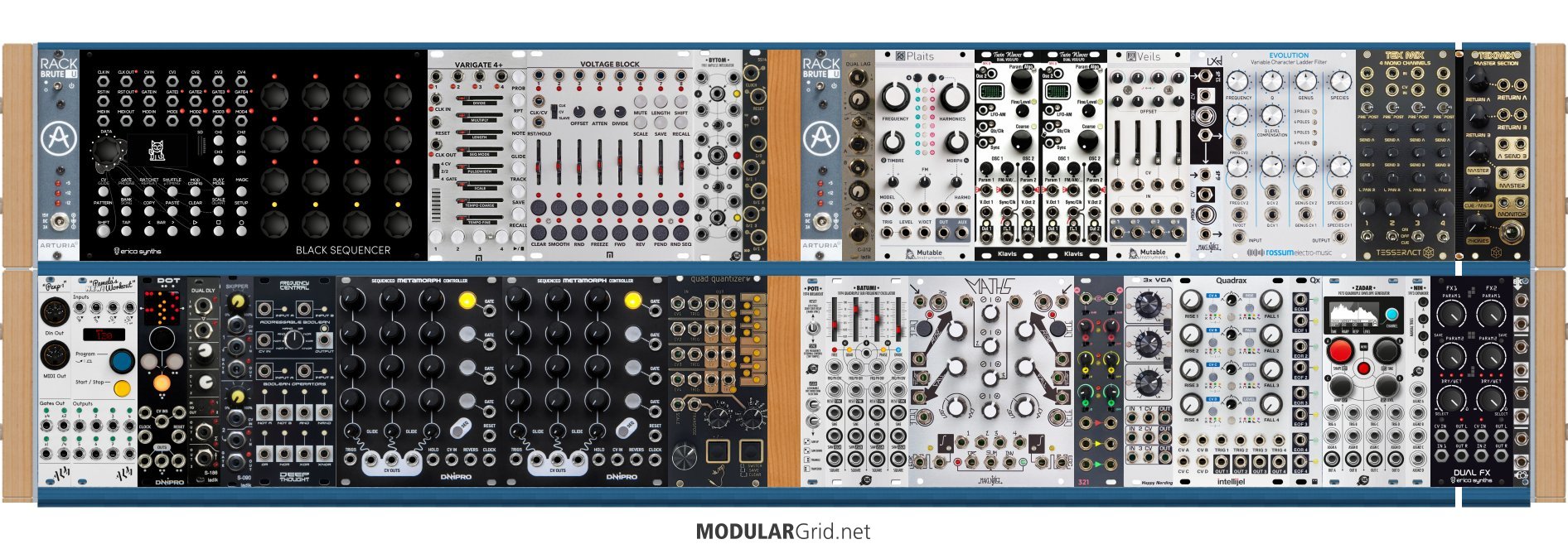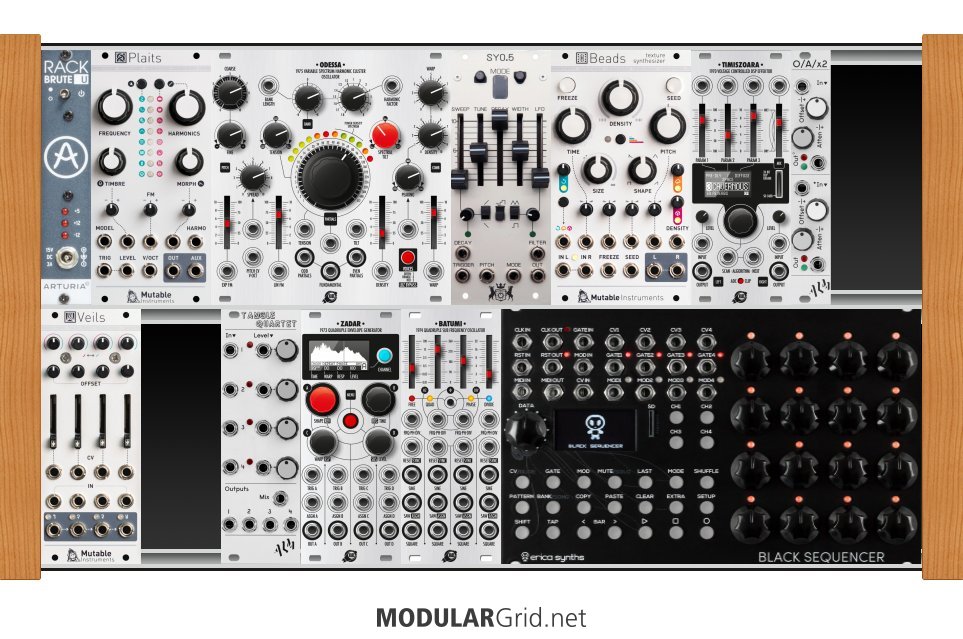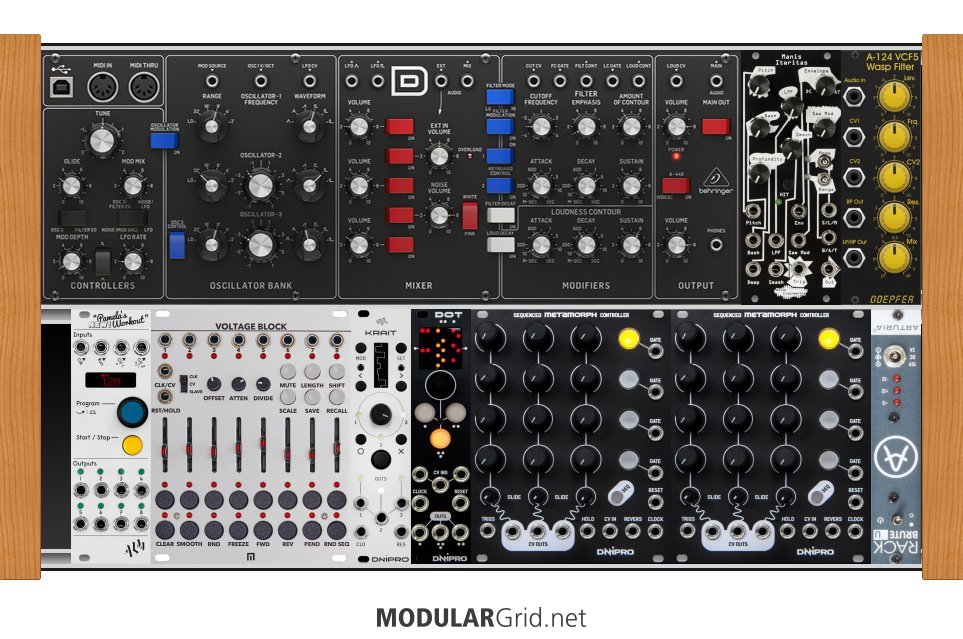Hmmm...OK, I went off on this, and I think I've got a better solution AND a rationale for removing the Model D.

In this version, I have the two cabs side-by-side, mainly to show the division of labor between the two cabs. These could just as easily be on "top" of each other, though, although the left cab should probably be the one on the bottom if this is done.
LEFT TOP: P/S, Black Sequencer, and then the Voltage Block WITH the Varigate 4+ that serves as its memory, controller, etc. After that is a Xaoc Bytom, a multichannel OR + gate/trig distributor...very useful in situations such as this. The last bit there is a XODES bidirectional 4-1 sequential switch, positioned so that it's adjacent to the "voicing" row in the right cab.
LEFT BOTTOM: Pam's expander and Pam's...expander was put on the left to minimize "outside" cables getting confused with patchcords. Then the DOT trigger sequencer, and after it are some basic clock modifiers...a dual pulse delay and a two-channel probabilistic pulse skipper. These support the Boolean logic module, a Frequency Central Deep Thought dual Boolean gate.
If you're wondering what the Boolean logic is for, here's an explanation: Boolean logic uses specific conditional gates which output a gate pulse when certain conditions are met. For example, if two incoming gate signals overlap, Boolean logic can obtain new gates via either an AND (when both inputs are 'high' this outputs a gate), OR (when only one gate is supposed to be "high"...having both or neither inputs hot = nothing) and so on. With a decent Boolean module and some modules to screw with the timing pulses, you can have even MORE clocking or weird conditional states with which to drive all of the sequencers...or anything else that wants a gate!
Anyway, after that are the two Metamorphs, and then I added a Tenderfoot Quad Quantizer for quantizing the sequencers that don't have internal quantization...or to just quantize modulation signals, which can be a really beautiful sound when something like an LFO on sawtooth gets quantized into ascending tessalations.
RIGHT TOP: Voice row. P/S first, then a Ladik dual lag for portamento, etc. Then Plaits...and then, some fun! The two next modules are Klavis Twin Waves mkiis...which are dual wavetable VCOs with internal quantization plus random capabilities, which gives you a total of five (or potentially six with the AUX out on the Plaits) oscillators in this version. Veils goes after that to offer CV control over (most of) the oscillator outputs; outputs that it DOESN'T have space for, though, are easily repurposed as audio-frequency modulators. After that, you've got a dual lowpass gate, Make Noise's LxD, then a way more interesting and complex VCF from Dave Rossum that offers changeable slopes, improved resonance control, sweepable filter types, and so on; this is pretty much perfect as a singular VCF in this sort of build. And at the end is a 4-in, 2-out Tesseract Tex-Mix setup which gives you a VCA input, two FX sends, and panning control across the four inputs, and the output section has the master level, headphone preamp, and I/O for the two FX sends and two stereo FX returns. Got hipped to the Tex-Mix by Jim...and when space is key, it actually is one of the smaller VCA-equipped performance mixers out there.
RIGHT BOTTOM: Modulation, mostly. Batumi (with Poti expander) first, then the ultraversatileness that IS the Maths. After that, you'll notice a Frap 321 and a Happy Nerding 3xVCA...these modules are there specifically to tamper with and alter modulation signals in a large variety of methods, allowing you to derive even MORE (and potentially screwier!) signals from just a few modulation generators. And speaking of those, there's a Quadrax/Qx combo next...the Qx really rips the lid off of the Quadrax by bringing the EOR and EOF signals out, and then these can be used to fire other EGs in the Quadrax; fact is, you could turn this one module, with the use of the Qx, into a cascading AR envelope set with successive EOR -> next TRIG patches which ALSO has CV over the attack and/or release...in short, a totally batshit insane waveform generator! Then the Zadar/Nin is next for "normal" envelope generation...and of course, there's loads of sources to trigger those, ergo the Nin's presence in here. The Dual FX is next (which is perfect for the Tex-Mix's FX bussing: 2 mono sends, 2 stereo returns). And that last sliver is a quad level adjuster, which takes synth-levels down to line-levels. Two, natch, get used for the Tex-Mix outs, which leaves two others to be used as "isolated" outs for a leadline, etc.
So...loads more complex, but majorly improved. Some of the initial modules did get bumped here so that other, better solutions could be pursued...which is also the rationale for pulling the Model D out. It's a good synth, to be sure, but THIS is where you could conceivably get to once it's gone.




